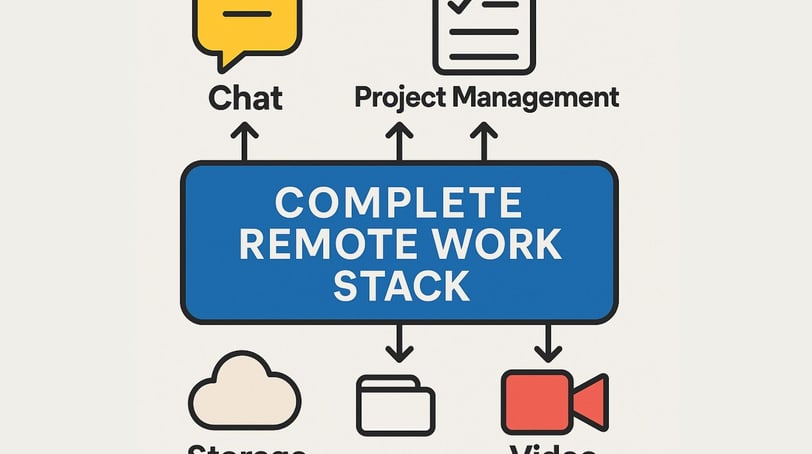Best Free Remote Work Tools for Teams 2025


The world of work has fundamentally shifted, and for many teams, operating remotely is the new standard. While this brings flexibility, it also presents challenges in communication, project tracking, and maintaining team synergy.
Finding the right tools is crucial, but equipping your team doesn't have to drain your budget. This guide explores the Best Free Remote Work Tools for Teams 2025, covering everything from free project management tools for remote teams to remote video conferencing tools free 2025, helping you build an effective and entirely cost-free digital workspace.
We'll navigate the top choices for collaboration, task management, file sharing, and more, ensuring your virtual team has the essential free tools for virtual teams in 2025 to thrive.
Remote Work is Evolving—Are Your Tools Keeping Up?
It's no secret that the traditional office structure has undergone a seismic shift. Remote and hybrid models are no longer niche concepts but mainstream realities for countless organizations.
This evolution brings incredible benefits – access to global talent, improved work-life balance for employees, and reduced overheads. Yet, it simultaneously introduces hurdles. How do you maintain seamless communication when colleagues are scattered across time zones?
How do you keep projects on track without the visual cues of an office environment? How do you foster a sense of team unity when physical proximity is gone?
The answer lies heavily in the digital toolkit you employ. Simply managing emails and occasional calls isn't enough anymore. Modern remote teams need robust platforms that facilitate real-time interaction, transparent workflows, and easy access to shared resources.
This is where the challenge often arises for startups, small businesses, or non-profits operating on tight budgets. Investing in premium software suites can be prohibitive. Luckily, the landscape of remote work productivity tools free has matured significantly.
It is entirely possible to assemble a powerful, functional, and secure remote work environment using high-quality tools that cost absolutely nothing. This isn't about compromise; it's about smart selection.
Understanding which tools to manage remote employees free are truly effective is key to unlocking your team's potential in 2025 and beyond.
Are your current tools truly empowering your distributed team, or are they creating friction? Let's explore the solutions that can bridge the gap.
Top Free Collaboration Tools for Remote Teams
Collaboration is the lifeblood of any successful team, and it takes on even greater importance in a remote setting. Misunderstandings can escalate quickly without face-to-face nuances. Therefore, having reliable, intuitive, and free channels for communication and joint work is non-negotiable. The good news? There's a wealth of excellent options among the best free collaboration tools for remote work.
Real-time & Asynchronous Communication:
Instant messaging platforms are the virtual water coolers and quick-huddle spots of remote teams.
Slack (Free Plan): A giant in the team chat space, Slack's free tier provides searchable message history (up to 90 days), 1-to-1 voice and video calls, and integrations with a limited number of other apps (like Google Drive).
It is excellent for quick questions, team announcements, and organizing conversations into channels (#project-alpha, #marketing, #random). While the message history limit can be a constraint for some, its user-friendly interface makes it a popular starting point for many team collaboration software for startups.
Microsoft Teams (Free Version): If your team leans towards the Microsoft ecosystem, the free version of Teams is a powerful contender. It includes unlimited chat messages and search, built-in online meetings with screen sharing (up to 60 minutes and 100 participants), and 5GB of cloud storage per team plus 10GB of shared storage.
It integrates seamlessly with other Microsoft 365 apps, though the free version is a standalone offering. It's a strong candidate among free team communication apps 2025.
Visual Brainstorming & Planning:
Sometimes, text isn't enough. Virtual whiteboards allow teams to brainstorm, mind-map, and plan visually, just like they would in a physical meeting room.
Miro (Free Plan): Miro provides an infinite canvas with three editable boards on its free plan. It comes packed with templates for brainstorming, flowcharts, Kanban boards, and more. Real-time collaboration is smooth, making it feel like you're sketching ideas together. It’s a fantastic free virtual whiteboard tool for creative sessions or visualizing workflows.
FigJam by Figma (Free Plan): From the makers of the popular design tool Figma, FigJam is specifically built for collaborative brainstorming. The free "Starter" plan includes unlimited personal files and three shared team files, plus core features like sticky notes, drawing tools, shapes, and templates. It's incredibly intuitive and fun to use.
Document Co-creation:
Working together on documents, spreadsheets, and presentations is fundamental.
Google Workspace Essentials Starter: While the full Google Workspace has costs, the Essentials Starter plan provides access to Google Drive, Docs, Sheets, Slides, and Meet for secure collaboration without requiring Gmail or a domain. It focuses purely on the collaborative apps and includes pooled storage, making it a great document collaboration tool for remote teams already familiar with Google's suite.
Notion (Free Plan): Notion goes beyond simple documents. It's a versatile workspace combining notes, documents, wikis, and project management capabilities. The free personal plan allows extensive individual use and limited block storage for collaboration, making it suitable for small teams building knowledge bases or managing shared documentation.
Selecting the right mix from these best free collaboration tools for remote work depends on your team's specific needs and existing workflows, but effective options abound.
Best Project Management Software Free
Keeping track of who's doing what, by when, is paramount for remote productivity. Scattered tasks and missed deadlines can derail projects quickly.
Thankfully, several robust free project management tools for remote teams bring clarity and structure without the price tag. These tools help visualize workflows, assign responsibilities, and monitor progress effectively.
Trello (Free Plan): Trello's visual Kanban board approach is legendary for its simplicity and effectiveness. You create boards for projects, lists for stages (e.g., To Do, Doing, Done), and cards for individual tasks. Cards can hold descriptions, checklists, due dates, attachments, and assignees.
The free plan includes unlimited personal boards, cards, and lists, up to 10 team boards, and basic automation capabilities (Butler). It's incredibly intuitive and perfect for teams that appreciate a visual overview, making it a top choice for free task management tools for small teams.
Asana (Free Plan): Asana is a more feature-rich option, suitable for teams needing various project views (list, board, calendar). The free plan supports up to 15 users and includes unlimited tasks, projects, messages, activity log, and file storage (100MB per file limit). You get core project management features, making it a step up in complexity from Trello but still very manageable and powerful for coordinating remote work.
ClickUp (Free Plan): ClickUp aims to be the "one app to replace them all." Its free plan is remarkably generous, including unlimited tasks, unlimited members, multiple views (List, Board, Calendar), real-time chat, collaborative docs, whiteboards, and 100MB of storage.
While the sheer number of features can feel overwhelming initially, its flexibility is unmatched in the free tier, catering to diverse project management styles. It’s a strong contender if you're looking for comprehensive remote work productivity tools free.
Choosing the best project management software free often comes down to your team's preferred workflow style. Trello excels in visual simplicity, Asana provides structured versatility, and ClickUp delivers extensive features for those willing to explore them.
The Best Free Video Conferencing Tools in 2025
Face-to-face interaction, even virtually, builds rapport and clarifies communication in ways text cannot. Reliable video conferencing is essential for team meetings, client calls, and one-on-one check-ins. Several excellent remote video conferencing tools free 2025 keep teams connected visually.
Zoom (Free Plan): Zoom became synonymous with video calls for a reason. Its free plan allows meetings up to 100 participants but limits group meetings (3+ participants) to 40 minutes. One-on-one meetings are unlimited. It offers screen sharing, virtual backgrounds, chat, and breakout rooms (though the latter might be less reliable on the free tier). Despite the time limit, its stability and ease of use keep it popular.
Google Meet (Free Version): Accessible with just a Google account, Google Meet allows meetings up to 100 participants for up to 60 minutes on its free tier. It offers screen sharing, adjustable layouts, captions, and integrates smoothly with Google Calendar. Its web-based accessibility (no mandatory app download for participants) is a significant plus.
Whereby (Free Plan): Whereby focuses on simplicity. The free plan allows meetings for up to 100 participants (though only one meeting room per user) with unlimited group meetings up to 45 minutes and unlimited 1-on-1 meetings. No downloads are required; meetings run directly in the browser via a personalized room link (e.g., whereby.com/your-team-name). It integrates with Miro for whiteboarding sessions.
While free plans have limitations (usually time or participant caps), they are more than sufficient for the daily meeting needs of many small remote teams. Evaluating factors like meeting duration requirements and preferred user experience will guide you to the best fit.
Secure Cloud Storage Options (100% Free)
Remote teams live and breathe digital files. Having a centralized, accessible, and secure place to store and share documents, images, and project files is critical. Thankfully, reliable free cloud storage for remote teams is readily available, providing essential remote file sharing tools free of charge.
Google Drive: Every free Google Account comes with 15GB of free storage shared across Drive, Gmail, and Google Photos. Google Drive offers seamless integration with Google Docs, Sheets, and Slides for real-time collaboration. Its sharing permissions are granular, allowing control over who can view, comment, or edit files and folders. It's a widely used and dependable option.
Dropbox Basic: The free Dropbox Basic plan starts with 2GB of storage, which might seem small but is sufficient for essential document sharing. Dropbox excels at file synchronization across devices and platforms. Its user interface is clean, and sharing files or folders with internal or external collaborators is straightforward.
Microsoft OneDrive Basic: Similar to Google Drive, OneDrive Basic provides 5GB of free storage with a Microsoft account. It integrates deeply with Windows and Microsoft 365 applications (even the free web versions). If your team primarily uses Microsoft tools, OneDrive is a natural fit for storing and sharing files.
A Note on Security: While these providers employ robust security measures, remember that data security is a shared responsibility. Encourage your team to use strong, unique passwords, enable two-factor authentication where available, and be mindful of sharing permissions. Regularly review who has access to sensitive files. These free options provide a solid foundation for remote file sharing tools free, but always prioritize security best practices.
How to Build a Fully Free Remote Work Stack
Creating a productive remote work environment without spending a dime is achievable by strategically combining the tools we've discussed. Here’s how to manage a remote team for free by building a cohesive "stack":
1. Identify Core Needs: Start by listing your team's essential functions. Typically, this includes:
Communication: Real-time chat and occasional video calls.
Project/Task Management: Tracking work progress and assignments.
File Storage & Sharing: Accessing and collaborating on documents.
(Optional) Specialized Needs: Whiteboarding, time tracking (some PM tools have basic free versions, or dedicated tools like Clockify have free tiers - Keyword: time tracking tools for remote workers free), etc.
2. Select Your Primary Tools: Choose one primary tool for each core need, considering potential integrations and team familiarity. A common stack might look like this:
Communication: Slack (Free) for daily chat + Google Meet (Free) for scheduled video calls.
Project Management: Trello (Free) for visual task tracking.
File Storage: Google Drive (Free) for document collaboration and storage.
Whiteboarding: Miro (Free) for brainstorming sessions.
3. Leverage Integrations (Where Possible): Even free tiers sometimes allow basic integrations. For example, connecting Google Drive to Trello cards or Slack can streamline workflows slightly. Explore the limited integration options available on the free plans of your chosen tools.
4. Establish Clear Usage Guidelines: Since you're using multiple tools, define when and how each tool should be used. For instance:
Urgent matters: Use Slack direct messages.
Project updates: Post in the relevant Trello card comments.
Formal announcements: Use a dedicated Slack channel.
Meeting invites: Use Google Calendar integrated with Google Meet.
Final documents: Store in the designated Google Drive folder.
5. Acknowledge Limitations: Be realistic. Free plans have constraints – storage limits, feature caps, limited history, fewer integrations.
Ensure these limitations don't critically impede your team's workflow. Sometimes, the combined friction of managing multiple free tools might eventually warrant a low-cost paid plan for a more integrated solution, but starting free is often the best approach for team collaboration software for startups.
Building a stack of the best free remote work tools for teams 2025 requires thoughtful selection and clear communication. It proves that empowering your distributed team with effective tools to manage remote employees free is entirely feasible, allowing you to focus resources on growth and innovation.
Conclusion
Navigating the world of remote work successfully hinges on having the right digital infrastructure. As we've explored, equipping your team in 2025 doesn't necessitate hefty software subscriptions.
From seamless communication via free team communication apps 2025 to organized workflows managed by free project management tools for remote teams, and secure file handling with free cloud storage for remote teams, a powerful and entirely free toolkit is within reach.
By carefully selecting tools like Slack, Trello, Google Drive, and Miro, and understanding how they fit together, you can build a robust digital headquarters. Remember to choose based on your team's specific needs and workflows.
While free tiers have limitations, their capabilities are often more than sufficient for small teams, startups, and budget-conscious organizations.
Embrace these essential free tools for virtual teams in 2025 and empower your remote workforce to collaborate effectively, stay productive, and achieve great things together, no matter where they are located.




